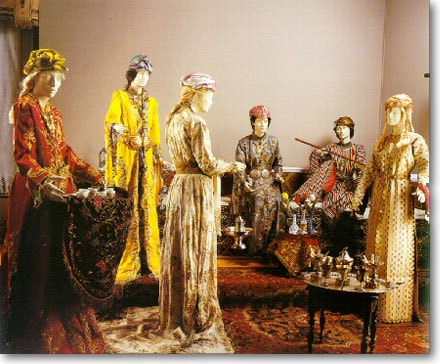The decorative patterns of the sultans’ clothing were drawn up by palace miniaturists, who made up a large part of the court’s artists and artisans working for the court, or ehl-i hýref. Besides serâser cloth, the sultans’ garments would be made with expensive silks such as velvet, çatma velvet with raised designs, kemha or velvet pile. Beginning in the time of Sultan Ahmed III (r. 1703–30), these heavy and expensive fabrics—with their large amount of gold and silver thread—were replaced with lighter and simpler fabrics such as satin, taffeta, gezi (thickly woven silk cloth), canfes (thin taffeta), sandal (a mixture of cotton and silk), geremsut silk, and selimiye (silk cloth made in workshops near Istanbul’s Selimiye barracks).
For the Ottoman sultans, headgear not only completed an outfit, but also served as an importantstatus symbol. During ceremonies and on reception days, sultans would wear headgear called horasanî, mücevveze, selimî, or kâtibî.
Another important piece of Ottoman headgear was the fez. In 1827, Sultan Mahmud II issued an imperial decree abolishing the Janissary corps and establishing a new army called the `Asâkir-i Mansûre-i Muhammediye (Victorious Soldiers of Muhammad), whose mandatory uniform consisted not only of coat and trousers, but also of the fez. Subsequently, a new clothing regulation was introduced, obliging all state employees and religious scholars to wear the fez. This clothing reform of Sultan Mahmud II served as a means of promotion for the radical changes he brought to the structure of the Ottoman state. The introduction of the fez resulted in other kinds of headgear losing their function as status symbols.



Hiç yorum yok:
Yorum Gönder